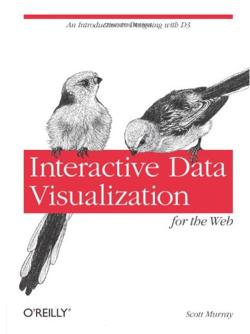| Interactive Data Visualization For The Web |
|
Author: Scott Murray While the title of this book suggests general data visualization, the subtitle ‘An introduction to designing with D3’ gives a more accurate picture of the contents. D3 is a JavaScript library that you can use to show data graphically, and Scott Murray has written an introduction to using it. The book started life as a set of online tutorials posted on Murray’s website, and much of the material in the book can be viewed there. The book does contain new material, along with 78 percent more bad jokes (so Murray promises).
Murray has an easygoing reading style, and introduces material as a set of tutorials. He starts from the very basics of what D3 is, how to download it, Web basics such as HTML, CSS, and DOM, then gets on to JavaScript and SVG. From that point onwards Murray goes step by step through setting up a page with page elements and binding data. The first real visualization in the sense of a chart is unsurprisingly a bar chart, which is then enhanced with colors, labels, scales and axes. Murray also shows how to create other visualizations including scatter charts, pie charts, stacked bar charts, and force layouts (where the data elements are laid out as elements with connections, as in a network graph or graph database).
Once you’ve got the basics of charts, you can make use of the fact you’re showing them on a screen rather than on paper by updating the data or display in response to user interaction – button pressing, for example. Transitions from one graph display to the next and how to delay and time them are also covered. Interactivity gets a chapter on its own, with more coverage of how to react to user interactions and how to set up tooltips to give the user more information. There’s a short section on dealing with touch screen devices. As Murray points out, touches are handled as click events, but you have to deal with how to handle multitouch events yourself. There’s a chapter on geomapping looking at GeoJSON that starts from a simple map projection and goes on to look at Chloropleth where map items such as states or countries are colored differently to represent associated data values. The classic use of this is the red state/blue state maps at US election time for Republican and Democrat, but Chloropleth has many more uses. Murray also shows how to add point values to your maps, and even how to create your own GeoJSON file for use with D3 for those developers who are working with data not already covered by the existing files. This was a short section of a few pages, but might be the basis of more customized solutions. The book is well written and while it’s code dense, the descriptions are easy to read and understand. There are reports that the Kindle version of the book has formatting errors with missing letters, but the paperback edition and other electronic formats are fine, and the layout is good with nice use of color.
|
|||
| Last Updated ( Tuesday, 27 August 2013 ) |

